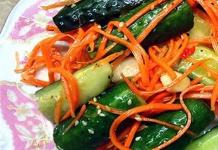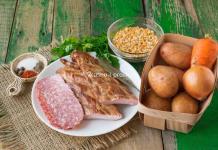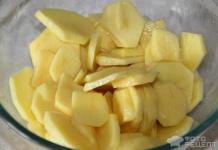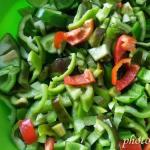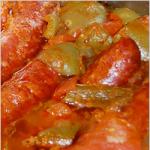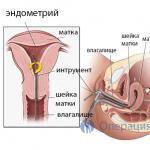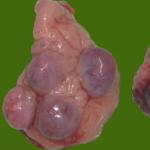Millet porridge has a rich vitamin and mineral composition, including vitamins B1, B2, PP, E, calcium, sodium, phosphorus, magnesium, potassium, and iron.
The calorie content of millet porridge with milk and sugar per 100 grams is 238 kcal. In 100 g of dish there are 6.6 g of protein, 7 g of fat, 38 g of carbohydrates.
To prepare porridge you need the following ingredients:
- 0.5 kg of millet cereal;
- 2 glasses of milk;
- 50 g butter;
- 2 tablespoons sugar;
- salt to taste.
- washed millet cereal is added to boiled milk;
- millet is cooked over low heat, stirred periodically for 20 minutes;
- add salt and sugar to the porridge, leave covered for 12 minutes;
- Add 50 g of butter to the finished porridge.
Calorie content per 100 grams of millet porridge on water
The calorie content of millet porridge with water per 100 grams is 89 kcal. In 100 g of dish there are 2.9 g of protein, 0.8 g of fat, 16.8 g of carbohydrates.
Porridge cooked in water is saturated with manganese, iron, magnesium, fluorine, copper, and silicon. Due to its fat-burning effect and low calorie content, the product is indicated for weight loss.
Calorie content of millet porridge with butter per 100 grams
The calorie content per 100 grams of millet porridge with butter depends on the recipe for preparing the dish. The most popular option is millet cereal cooked in milk with sugar-free butter. This porridge contains 103 kcal, 3.7 g of protein, 5.4 g of fat, and 10.2 g of carbohydrates per 100-gram serving.
- 1 glass of washed millet is poured with 0.2 liters of milk and simmered over low heat until ready;
- add salt to the porridge to taste, add 5 g of butter right before serving.
The benefits of millet porridge
Boiled millet porridge has a lot of useful properties. The benefits of boiled millet cereals are as follows:
- it cleanses the body of toxins and antibiotics;
- This porridge without added sugar is a low-calorie dietary product, so it is recommended to prepare the dish if you are losing weight or extra pounds;
- millet porridge is rich in B vitamins and potassium, which are useful for the prevention of diseases of the nervous system, heart, and blood vessels;
- the dish contains many essential amino acids that ensure healthy skin and muscles;
- porridge is rich in slow carbohydrates, which saturate the body with energy and reduce appetite;
- vegetable fats of porridge are necessary for the health of eyes, hair, nails;
- In folk beauty recipes, boiled millet porridge is used in masks for the face and hands.
Harm of millet porridge
Despite the fact that millet porridge is an extremely healthy product, in some cases its use is harmful:
- overeating porridge impairs the absorption of iodine, which, in turn, provokes memory impairment and disturbances in the functioning of the thyroid gland;
- sometimes millet porridge causes intolerance and allergic reactions;
- contraindications to the use of the product are aggravated stomach diseases, low acidity, inflammatory processes in the intestines;
- If you have hypothyroidism, you should reduce the amount of porridge consumed daily.
For residents of our country, porridge is a traditional dish. Our ancestors, using them, were strong and resilient. Today we have moved away from traditional nutrition. And we use much less cereals for making porridge.
But, if you want to switch from junk food, which takes up more and more of our diet today, then pay attention to cereals. These natural products will make your diet tasty and healthy.
Calorie content of buckwheat
You can buy two types of buckwheat in the store: kernel and prodel. Krupa kernel is a whole kernel. Prodel, these are the split kernels of this cereal. Both types of buckwheat are useful. The kernel takes 2 times longer to cook than it took. You can also buy buckwheat flakes in the store. They don't need to be boiled. Simply pour boiling water over it.
Buckwheat is a rich source of many beneficial elements and amino acids. It’s not for nothing that buckwheat is called the queen of cereals. It contains large quantities of phosphorus, iron, iodine, vitamins B, PP and E. In addition, buckwheat is rich in fiber and essential amino acids. That is why this cereal is considered the best meat substitute in vegetarianism.
Calorie content of buckwheat porridge (100 g): 132 kcal
Calorie content of millet
Millet is another type of cereal that is a rich source of many beneficial compounds.Vegetable fats, proteins and vitamins from millet will provide the body with an invaluable service. And fiber will cleanse the intestines of toxins and waste. This cereal is especially useful for people suffering from gastrointestinal disorders and liver diseases.
The nutritional value of millet is high. It contains a lot of protein. According to this indicator, millet will give odds to rice and barley. Moreover, millet protein has a unique amino acid composition and is easily absorbed by the body.
Calorie content of millet porridge on water (100 g): 90 kcal.
Calorie content of rice

 White rice, which is sold in our grocery stores, is rice that has undergone multi-stage cleaning and processing (grinding)
White rice, which is sold in our grocery stores, is rice that has undergone multi-stage cleaning and processing (grinding) This cereal is divided into long-grain, medium-grain and short-grain. Polished rice contains less nutrients than parboiled rice.
Unlike the healthier types of wild and brown rice, white rice is the most consumed grain in the world. Its advantages are a wide cultivation area, pleasant taste and excellent appearance.
Calorie content of rice porridge per milk (100 g): 97 kcal.
Calorie content of black (wild) rice

 Although this cereal is called rice, it has nothing to do with its white “brother”.
Although this cereal is called rice, it has nothing to do with its white “brother”. Although he is a very distant relative. Black rice is a grass of the water tsitsaniya plant. This product contains a lot of thiamine, which protects cells from oxidation.
Another compound that wild rice is proud of is folic acid. One glass of this cereal contains the daily requirement of this useful substance.
Calorie content of wild cooked rice (100 g): 100 kcal.
Brown rice calories

 Brown rice contains many beneficial compounds for humans:
Brown rice contains many beneficial compounds for humans: thiamine, riboflavin, niacin and vitamin B6. The protein composition of this cereal includes eight amino acids, including three essential for the body.
Unlike other grains, brown rice does not contain gluten. This protein may cause allergic reactions in some people.
Calorie content of boiled brown rice (100 g): 89 kcal.
Calorie content of pearl barley

 Pearl barley is one of the healthiest foods for the body.
Pearl barley is one of the healthiest foods for the body. It contains many vitamins and minerals. Barley is useful to eat because of its rich amino acid composition. This cereal contains lysine. An amino acid that prevents premature cell aging and fights herpes.
Pearl barley also contains a lot of selenium, a powerful antioxidant. If you want to prolong your youth, be sure to include pearl barley in your diet.
Calorie content of pearl barley porridge with pumpkin (100 g): 63 kcal.
Calorie content of barley

 Like pearl barley, barley groats are made from barley.
Like pearl barley, barley groats are made from barley. But, unlike the latter, the method of grinding and polishing is not used in the production of this cereal. This means that after processing, many useful substances remain in this cereal.
Barley groats are appreciated by nutritionists. It ranks second in terms of the content of biologically active substances beneficial to the body. And in this indicator it is second only to buckwheat.
Calorie content of barley porridge on water (100 g): 76 kcal.
Wheat calories

 Fiber, which wheat is rich in, is a powerful stimulator of intestinal function.
Fiber, which wheat is rich in, is a powerful stimulator of intestinal function. Such compounds reduce the development of putrefactive processes in the body by absorbing harmful substances.
Wheat contains a lot of potassium and magnesium. Elements that participate in the human body in the processes of bone tissue formation and support the functioning of the cardiovascular system. Stew made from fried wheat flour is one of the best remedies for restoring lactation.
Calorie content of wheat porridge (100 g): 107 kcal.
Calorie content of oatmeal

 Probably everyone has heard the popular opinion that it is best to start your day with oatmeal.
Probably everyone has heard the popular opinion that it is best to start your day with oatmeal. With its help, you can raise your tone, remove toxins and other harmful compounds from the body. According to eminent nutritionists, oatmeal is absorbed by the body better than other foods. With the help of this cereal you can normalize the functioning of the liver, kidneys, and thyroid gland.
Oatmeal is very useful during pregnancy. It is a source of folic acid. The main element for the proper formation of the fetus.
Calorie content of oatmeal with milk (100 g): 102 kcal.
Calorie content of semolina

 Semolina contains a lot of potassium
Semolina contains a lot of potassium This vital trace element ensures normal heart function. In addition, semolina contains a lot of iron. With its help, you can renew the red blood cells in your blood. It is also important to consume semolina porridge in order to provide the nervous system with the B vitamins it needs.
The small amount of fiber in semolina porridge made this product the best as part of a diet aimed at treating gastrointestinal diseases.
Calorie content of semolina porridge with milk (100 g): 98 kcal.
Calorie content of rolled oats

 Rolled oats are made from oats
Rolled oats are made from oats This cereal is famous for its balanced composition. It contains 11-20% protein, 4-8% vegetable fat and about 65% carbohydrates. In addition, rolled oats are a valuable source of many beneficial compounds, vitamins and minerals necessary for humans. This product is ideal for baby food, as it leads to the full development of the growing body.
Rolled oats contain a lot of “slow” carbohydrates. Thanks to them, the feeling of fullness lasts longer. That is why rolled oats are ideal as a basis for dietary nutrition. This product should also be included in the diet if you have diabetes. Hercules is able to normalize blood sugar levels.
Calorie content of oatmeal porridge with milk (100 g): 135.8 kcal.
Quinoa calories

 Quinoa is a so-called “superfood”
Quinoa is a so-called “superfood” In terms of its effects, it cannot be compared with any other cereal. Quinoa is a valuable source of plant protein. Some varieties of this cereal contain up to 20% easily digestible protein.
Quinoa protein has a unique amino acid composition. It contains several compounds essential for the human body. Including lysine, a compound through which calcium is absorbed. That is why quinoa is indicated for people suffering from arthritis, arthrosis and other similar diseases.
Calorie content of quinoa porridge (100 g): 120 kcal.
Calorie content of lentils

 The fruits of this legume family plant are unique
The fruits of this legume family plant are unique During the growth process, lentils do not accumulate toxins and nitrates. Which makes it a very environmentally friendly product. Moreover, lentils themselves can remove waste and toxins from the body. And its isoflavones can reduce the level of cancer cells in the body.
Lentils are considered one of the leaders in iron and folic acid content among all plant foods. In addition, it is very high in fiber and B vitamins. Lentils are a rich source of vegetable protein.
Calorie content of boiled lentils (100 g): 111 kcal.
Calorie content of peas

 Peas, like all legumes, contain a very large amount of easily digestible vegetable protein
Peas, like all legumes, contain a very large amount of easily digestible vegetable protein Also, the advantage of this culture is the presence of lysine in its amino acid composition. And pyridoxine, which peas are also rich in, helps improve skin structure and reduce the risk of developing seizures.
Peas are rich in selenium. This mineral has an anti-carcinogenic effect and helps remove radioactive metals from the body. Previously, heartburn was treated with crushed pea grains, and diabetes was treated with pea flour.
Calorie content of lean pea porridge (100 g): 89.4 kcal.
Calorie content of beans

 Beans are another extremely useful legume product for the human body.
Beans are another extremely useful legume product for the human body. In terms of its nutritional values, bean protein is equal to meat protein. This product contains a lot of iron, which is why beans are used in diets against anemia. Beans also contain a lot of zinc, magnesium and calcium.
The diuretic property of beans is used to cleanse the kidneys. This product is indicated for overwork, nervous exhaustion and sports. The antibacterial properties of beans are used to treat oral diseases.
Calorie content of boiled red beans (100 g): 93 kcal.
Corn calories

 Corn has high biological and nutritional activity
Corn has high biological and nutritional activity With this product you can activate metabolic processes in the body. Thanks to this, you can increase vitality, well-being and the functioning of the immune system. Corn is also useful for excess weight.
Corn contains a large number of useful compounds that can have an anti-stress and calming effect on the nervous system. 150 grams of corn contains the daily requirement of vitamin B1.
Calorie content of boiled corn (100 g): 123 kcal.
Calorie content of beans

 When beans enter the body, they coat the walls of the stomach and prolong the feeling of fullness.
When beans enter the body, they coat the walls of the stomach and prolong the feeling of fullness. Do not forget that beans contain a lot of vegetable protein with a unique amino acid composition.
Beans have choleretic properties. This allows them to remove excess cholesterol and normalize blood sugar levels. Bean puree is also used for cosmetic purposes, as an anti-inflammatory mask.
Calorie content of boiled green beans (100 g): 36.54 kcal.
Calorie content of soybeans

 Soy, like beans, is used in an anti-cholesterol diet
Soy, like beans, is used in an anti-cholesterol diet According to the American Heart Association's Nutrition Committee, consuming just 50 grams of soy per day can reduce blood cholesterol levels by 20%.
Soy contains polyunsaturated fats, fiber, minerals and vitamins. But this is not what makes soy, like quinoa, the healthiest product in the world. It's all about the unique protein composition of soy. Thanks to him, this product can replace meat.
Calorie content of soy meat (100 g): 296 kcal.
Pivot table


| Calorie content of products (100 g): | |
| Buckwheat | 330 kcal |
| Millet cereal | 342 kcal |
| Rice | 303 kcal |
| Black (wild) rice | 101 kcal |
| 362 kcal | |
| Pearl barley | 315 kcal |
| Barley grits | 313 kcal |
| 305 kcal | |
| 88 kcal | |
| Semolina | 333 kcal |
| 352 kcal | |
| 120 kcal | |
| 295 kcal | |
| 298 kcal | |
| 298 kcal | |
| Corn | 96 kcal |
| Beans | 56.8 kcal |
| Soybeans | 364 kcal |
Olga. I really love quinoa porridge. This product has many benefits. And the calorie content is low. I cook it in a slow cooker. It turns out very tasty.
Victor. And I love buckwheat. Great product. Nutritious and healthy. And with my diabetes, you can’t imagine better porridge.
In a healthy diet menu, cereals occupy one of the central places, and millet is one of the five recommended for most frequent consumption. Unlike rice and buckwheat, it is served with dried fruits or seaweed, as well as pumpkin and walnuts. Millet does not mix with mushrooms, meat and fish. Rich in silicon, iron and magnesium, as well as fluorine and copper, it is indispensable for regulating the activity of the cardiovascular system, for anemia and low blood pressure and for diseases of the gastrointestinal tract. Although it is worth making one caveat here: in case of gastritis with high acidity, millet porridge should be excluded from the menu. This cereal is even credited with the ability to remove antibiotics and heavy metal salts from the body; waste and toxins need not be mentioned at all. And, what is very important for those who are watching their figure: millet prevents fat from settling in the wrong places.
As a result, those who care about slimness become interested in how many calories there are in millet porridge, and in what combinations it is best consumed for the purpose of weight loss.
How many calories are in millet porridge?
The simplest option is millet porridge cooked in water without adding salt and sugar. The calorie content of such a dish is only 90 kcal per 100 g, of which 78% is occupied by “fast” carbohydrates that are not converted into excess fat, 14% is given to proteins, and only 7% to fats. With such an energy value, it is difficult not to call millet useful for those who want to lose weight. Due to the presence of vegetable fats in it, which promote the absorption of vitamin D and carotene, this cereal is an ideal ally for carrots and pumpkin.
As for the calorie content of millet porridge with milk, it will increase and decrease depending on the fat content of the milk. But usually this value is within the range of 107-120 kcal per 100 g of finished product. If there are any additives, of course, the calorie content of millet porridge will increase, but there are several important points that will help, even with a high calorie content, to ensure the maximum harmlessness of the dish.
Millet porridge for weight loss
So, now that we have found out how many calories are in millet porridge depending on its base, it will be useful to find out how to cook it, maintaining the benefits and increasing the positive effect on the figure and the body as a whole. It makes no difference whether the dish is prepared in the oven, in a slow cooker, or simply in a pan on the stove: the calorie content of millet porridge will remain unchanged. But various combinations can not only affect the energy value, but also serve as an additional catalyst for weight loss.
One of the best “duets” in this area is undoubtedly millet and pumpkin. This is truly a striking tandem, since the first prevents the deposition of fat, and the second improves metabolic processes in the body - it is even prescribed for obesity and diabetes. Naturally, those who want to lose excess weight should not pass by for a long time and should include such a dish in their diet at least once every two weeks. What becomes a pleasant bonus is the calorie content of millet porridge with pumpkin in water: some 70 kcal per 100 g. And it tastes best in the oven, in a pot with thick walls: this way all the beneficial properties of both products will be preserved as much as possible.
Those with a sweet tooth can occasionally treat themselves by combining millet, cottage cheese, raisins and honey. True, in order to reduce the number of calories in millet porridge with such additives, it is better to take low-fat cottage cheese. Then the total “weight” of the dish will be within 180 kcal. And if such millet porridge is cooked in milk, its calorie content will be 220 kcal, but you can lower this figure by choosing milk with a minimum percentage of fat content. If you remove the cottage cheese and reduce the amount of raisins, the calorie indicator of millet porridge will become completely ridiculous, given its sweetness: only 91 kcal. Despite the fact that this is already calculated for the version prepared with milk.
 In addition to low-calorie recipes for this dish, there are also fasting days on millet, which, however, should not become a habit. Arranging such a day more than once a week is fraught with negative consequences for the body. But if you urgently need to lose a kilogram, then you need to boil 100 g of millet in water without salt and distribute it over four main meals. If desired, millet porridge can be supplemented with vegetables that are not subject to any cooking method. You should also include at least one and a half liters of green tea in the menu.
In addition to low-calorie recipes for this dish, there are also fasting days on millet, which, however, should not become a habit. Arranging such a day more than once a week is fraught with negative consequences for the body. But if you urgently need to lose a kilogram, then you need to boil 100 g of millet in water without salt and distribute it over four main meals. If desired, millet porridge can be supplemented with vegetables that are not subject to any cooking method. You should also include at least one and a half liters of green tea in the menu.
There are also various variations of the millet diet, designed for a week. The toughest involves the same fasting day, only it is repeated seven times. But in order to do something similar to your body, you need to have firm confidence in the absence of serious problems with the gastrointestinal tract. Therefore, if you really really want to lose weight urgently, it is better to give preference to more gentle options. For example, add a couple of egg whites to millet porridge and herbal teas for breakfast, stewed vegetables for lunch, and unsweetened fruit in the evening - kiwi, apple or citrus.
Millet porridge (millet) is a porridge prepared from millet cereals. Mostly it is cooked with milk. Served with butter, walnuts, prunes, pumpkin, seaweed.
Millet porridge provides the human body with manganese, magnesium, iron, and fluorine. In addition, millet contains copper and silicon.
Millet porridge is recommended for people suffering from anemia and diseases of the cardiovascular system. Some scientists even believe that millet porridge can remove antibiotics from the body.
Millet porridge can actually help remove antibiotics, heavy metal salts, prevent cholesterol deposits and cleanse blood vessels of it, and prevent fat deposits.
The calorie content of viscous millet porridge in water is 90 kcal. Proteins - 3.0 g, carbohydrates - 17.0 g, fats - 0.7 g.
However, this is not a complete list of the beneficial properties of millet - millet porridge contains essential amino acids - a kind of building material for the muscle system and skin cells, vegetable fats (a necessary component that helps the absorption of certain vitamins, including carotene and vitamin D), slowly digestible carbohydrates (cleanse the body of waste and toxins).
First you need to sort out the millet, then rinse it six to seven times until the water is clear. Finally, it is better to wash it in warm or even hot water so that the grain is slightly steamed.
Millet is boiled in a large volume of water until half cooked. The remaining water is drained. Then add milk and cook over low heat until the millet is completely boiled. At the same time, the greater the amount of milk, the longer the millet needs to be cooked, and the longer it is cooked, the tastier the porridge will be. Often the finished porridge is “acidified” by adding a little cottage cheese or yogurt to it - as a result, the flavors of the porridge become more subtle.
 Millet porridge can fill the human body with energy and also remove unnecessary mineral salts. Millet contains essential acids, which are the main building material for skin and muscle cells. Millet porridge supplies B vitamins in large quantities, in particular vitamins B1, B2 and B5. Millet contains almost the entire periodic table: copper, manganese, fluorine, iron, magnesium.
Millet porridge can fill the human body with energy and also remove unnecessary mineral salts. Millet contains essential acids, which are the main building material for skin and muscle cells. Millet porridge supplies B vitamins in large quantities, in particular vitamins B1, B2 and B5. Millet contains almost the entire periodic table: copper, manganese, fluorine, iron, magnesium.
Millet porridge can remove toxins and antibiotics from the body. It will not make you gain weight; millet not only fights excess fat deposits, but even removes it. Millet porridge is recommended for people who suffer from diseases associated with the cardiovascular system, because problems with cardiac activity require potassium, and millet is considered its richest source.
The calorie content of crumbly millet porridge is 135 kcal. The composition also contains proteins - 4.7 g, carbohydrates - 26.1 g, fats - 1.1 g.
Millet porridge is cooked in both water and milk. Before cooking, millet should be thoroughly rinsed with hot water until the water becomes clear. The porridge is generously poured with water, cooked until half cooked, and then the remaining water is drained and the porridge is cooked in milk until cooked.
 Myllyn Paras millet porridge is made from selected wheat grains that have been crushed into flakes. The porridge contains no additives or preservatives. It contains vitamins and minerals. It is great for making baby porridge.
Myllyn Paras millet porridge is made from selected wheat grains that have been crushed into flakes. The porridge contains no additives or preservatives. It contains vitamins and minerals. It is great for making baby porridge.
Ingredients: millet.
Cook: one minute.
In one box you will find 400 g of millet porridge from Myllyn Paras, which can be stored for no more than ten months.
The product contains selenium, phosphorus, zinc, sodium, calcium, iron, magnesium, calcium, as well as vitamins E, K, B1, B2.
The calorie content of millet porridge is 305 kcal. The composition also contains proteins - 11.2 g, carbohydrates - 55.3 g, fats - 3.9 g.
To prepare one serving of porridge, you need to add half a glass of porridge to 75% of a glass of boiling water and cook (stirring constantly) for one minute. The finished porridge can be varied by adding jam, butter, sugar and salt. After cooking, manufacturers advise letting the porridge simmer under the lid for about a minute.
Using this product you can also make millet balls. You will need to beat two chicken eggs into pre-prepared porridge brought to 40 °C (cooked from 0.4 liters of milk, 200 g of Myllyn Paras porridge, sugar and salt), knead thoroughly and make meatballs. Roll the resulting products in breadcrumbs and fry in butter in a fairly hot frying pan. Serve the golden balls hot with berry sauce. Such a treat will undoubtedly please both children and adults!
“Golden groats” is what millet was called in ancient times. However, not everyone knows that this name was formed not only because of the bright yellow color of the porridge, but also because of its nutritional properties and positive effect on the human body. Let's get acquainted in more detail with the properties, composition and features of using millet porridge.
Properties and glycemic index
Millet porridge has a very rich composition, filled with all kinds of useful substances and vitamins. It contains elements such as:
- iron;
- fluorine;
- magnesium;
- silicon;
- manganese.
Thanks to these components, many functions of the body are improved and some of its systems are strengthened. For example, millet porridge is among the nutritional recommendations for people suffering from cardiovascular diseases. Eating this dish has a positive effect on human immunity and also helps eliminate toxins and various harmful components from the body. The product can have a positive effect on the digestion process and bring it back to normal. In addition, millet porridge has a good effect on liver function and lipid metabolism, and helps keep cholesterol levels under control.
The level of the glycemic index directly depends on the consistency of the porridge. The thicker the boiled millet, the higher this indicator. Its maximum value can reach 70, and the indicator of a viscous and crumbly dish is about 50.


Nutritional and energy value
It is generally accepted that millet porridge is not the most filling, but at the same time it contains quite a lot of calories and has very high BJU indicators. This may turn out to be true if we consider, for example, the option of preparing a dish from childhood - with milk, with added sugar. But millet cooked in water, even with some additives, has much lower calorie content and has lower nutritional value. It is worth noting that very often the calorie content of dry cereal is radically different from the calorie content of the finished dish.
Let's take a closer look at the BJU.

Use for weight loss
It's no secret that the main source of energy necessary for the functioning of the nervous system, maintaining physical activity and many other processes in the body are carbohydrates. Millet porridge is rich in them, so when losing weight it can become an indispensable ally. However, it is worth considering that boiled millet is recommended to be consumed in the morning for breakfast, so that the amount of energy generated is consumed during the day.
There are undeniable benefits of eating this dish when losing weight:
- boiled cereals are fast-satisfying foods;
- millet can be added to salads, replacing other grains;
- in combination with pumpkin, porridge can get a sweetish taste, and by adding other ingredients you can even prepare a delicious dietary casserole;
- By adding foods that are a source of protein, you can easily create a complete and balanced diet.
There are not so many disadvantages of eating porridge when losing weight, and they are not so significant:
- some may need some time to get used to the taste of porridge cooked in water, without milk or butter;
- before cooking, it is necessary to rinse the cereal several times in clean water;
- The cooking process takes some time.
It is worth noting that this dish will be successfully included in the diet only of those who adhere to a stable amount of carbohydrates in their diet. At the same time, porridge is absolutely not suitable for those who are engaged in “drying” the body and preparing for competitions.

How to cook deliciously?
There are many recipes for preparing delicious millet porridge using water with the addition of other ingredients. Let's take a closer look at the most popular of them.
Porridge with pumpkin
Ingredients:
- pumpkin – 0.5 kg;
- millet – 1 tbsp;
- water – 3 tbsp;
- oil – 1 tsp.
The pumpkin should be washed, peeled and seeded, cut into medium-sized cubes. Then it needs to be immersed in the container chosen for cooking and cooked over low heat until medium soft. The millet should also be washed, pour boiling water and added to the pumpkin. Cook until the liquid has completely evaporated and the dish is completely cooked. If necessary, you can add a little more water. Before serving, the dish can be supplemented with sunflower oil or a small piece of butter.
